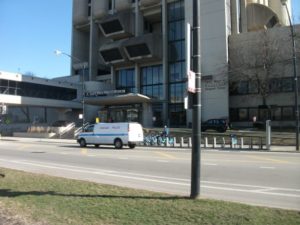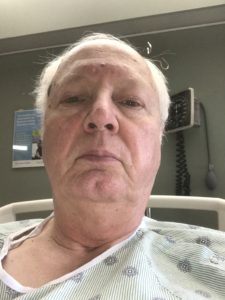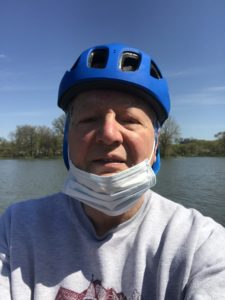 It started last Thursday evening after dinner. By 8 p.m., suffering shivers and chills and fatigue, I retreated to bed, unsure what was affecting me but hoping a solid night of sleep might provide some respite. I was near the end of two busy weeks. The previous week, I had been deeply involved in a huge experiment by the American Planning Association, which it called NPC20 @Home, a three-day online professional conference that would replace its canceled National Planning Conference, which would have taken place in Houston April 25-28. Instead, on opening day, April 29, I was moderating a session with three speakers[i] on “Demanding Equity: Planning for Post-Disaster Recovery.” We had rehearsed our approach, and it came off seamlessly before more than 1,600 participants, which made all of us very happy.
It started last Thursday evening after dinner. By 8 p.m., suffering shivers and chills and fatigue, I retreated to bed, unsure what was affecting me but hoping a solid night of sleep might provide some respite. I was near the end of two busy weeks. The previous week, I had been deeply involved in a huge experiment by the American Planning Association, which it called NPC20 @Home, a three-day online professional conference that would replace its canceled National Planning Conference, which would have taken place in Houston April 25-28. Instead, on opening day, April 29, I was moderating a session with three speakers[i] on “Demanding Equity: Planning for Post-Disaster Recovery.” We had rehearsed our approach, and it came off seamlessly before more than 1,600 participants, which made all of us very happy.
The following Monday, as chair of APA’s Hazard Mitigation and Disaster Recovery Planning Division (HMDR), I led our annual business meeting, which also had gone online after the NPC was canceled. With the support of our executive committee, particularly Christine Caggiano, our secretary-treasurer, who played the Wizard of Oz for our Zoom controls, it too had been a remarkable success with attendance spread across four time zones. So it went through Thursday, when two other speakers[ii] and I presented a webinar for APA’s Michigan chapter on the 2020 update of APA’s Hazard Mitigation Policy Guide. That was over by mid-afternoon; we patted ourselves on the back, and I went on to other business, such as a blog post that remains unfinished. I will get to it, I hope.
It was only as the evening progressed that I sensed something was wrong.
My wife, Jean, began to share fears that I was the latest victim of coronavirus. She, of course, was simply reacting to visible symptoms and venting her worst fears. But as the night wore on, my intuition led me in other directions, and I was unwilling to succumb to simple answers. Only I could experience and report all of my symptoms, which included a few trips to the bathroom, and it reminded me too much of previous experiences with prostatitis. In April 2012, on a flight to Los Angeles, I experienced chills and fever somewhere over the Rockies. Chicago to Los Angeles is about a four-hour flight, so I had to endure two hours of personal deterioration before landing at LAX, where I struggled to hold myself together as I grabbed my luggage and found a taxi to the hotel, where I could check in for that year’s National Planning Conference at the nearby convention center. At the hotel, I was already sweating as I checked in and found my room, where I remained for the evening, under bed covers, skipping nearly every event at which I was expected.
I was basically a physical wreck throughout the five-day conference, but, on the advice of my primary physician, found my way to a nearby urgent care center, where I was diagnosed with prostatitis, an infection of the prostate gland that can, under the worst conditions, kill the patient, as my urologist in Chicago later explained. I will say it was one of the worst experiences of illness in my entire life, and people who saw me when I made an occasional appearance outside my room uniformly commented on how awful I looked, and asked what was wrong.
Thursday night was nowhere near that bad, but still, it reminded me symptomatically of that experience.
Yet, by Friday morning, I thought I had perhaps gotten past it all. I felt reasonably okay, ate breakfast, dressed, and joined an online faculty meeting for the School of Urban and Regional Planning (SURP) at the University of Iowa, where I teach a course on disaster planning. Our discussion with the dean of the Graduate College, John Keller, focused on what might happen with on-campus instruction this coming fall, a question for which the answer was indeterminate.
Somewhere in the middle of that discussion, the malaise began to reassert itself, and I felt weak and tired. I sent a chat note to Charles Connerly, the director of SURP, saying that if I disappeared from the Zoom screen, it was because I was not well. Less than an hour into the meeting, I did exactly that, and went upstairs to our bedroom to rest. My wife noticed that my fever was not abating and worried that I needed medical attention. By noon, she insisted on taking me to the emergency room at nearby St. Mary’s Presence Hospital, and I gave in, not because I had resisted the idea but because I needed to muster the energy to get up and do it.
At the hospital door, a small group of security and admitting staff sought to ensure that I was arriving as a patient as I exited the passenger door of our car. I explained the situation. My wife and grandson could not join me because, amidst the coronavirus pandemic, and with most of the hospital devoted to such patients, no visitors are permitted. They had to wait in the car or go home, which they eventually did after picking up take-out lunch at a nearby Wendy’s. Once inside and admitted, I was on my own.
The first step by the nursing staff was to administer a COVID-19 test, putting swabs deep into my nasal cavity; it later proved negative. However, my temperature was 100.6° F. They did a battery of other tests based on my symptoms and concluded over the next few hours, as I sat in an ER unit, that I was suffering from a urinary tract infection (UTI). How I acquired it, I will probably never know, just as I never learned how I acquired prostatitis. All that matters is the treatment. I learned, to my deep disappointment, that I would be kept overnight for monitoring because of my history of prostate issues, which has included an almost fruitless search for evidence of cancer. I say “almost” because elevated PSA scores triggered the search nearly a decade ago, before the incident in Los Angeles, and on one occasion a fusion biopsy discovered a tiny sliver of affected tissue. But that finding has never occurred in all the years since. As a result, no treatment has been necessary. But still, caution was apparently in order when a UTI materialized.
The one reservation, of course, is that most of the hospital by May 8 was occupied by COVID-19 patients. One floor was reserved for non-COVID patients requiring hospitalization, and by 9:30 p.m., that is where I was sent. In the meantime, as evening approached, the attending nurse, Jesse, offered the use of his cell phone so that I could call my wife and ask her to bring my cell phone, my Nook e-reader, reading glasses, and power cords to help me escape boredom. He could see that, with nothing to do during long spells when nothing needed to be done (I already had an IV in my arm for a broad-spectrum antibiotic), I was becoming slightly stir crazy. Jean obliged by delivering the goods to the ER door, where Jesse retrieved them. My Nook contains dozens of books. They would relieve my anxiety and let me feel connected to friends and family, so that we could discuss what was happening.
One situation that disturbed me early in the evening was that I had promised to be part of two online events from 5 to 6 p.m. The first was to host the Zoom “room” for HMDR as part of a much larger invitation for members of any APA divisions to participate in a virtual Divisions Happy Hour. Given that HMDR has more than 1,500 members, and APA now has 22 divisions and eight “interest groups,” the number of registrants may have been rather large, but I never had time to check. It was surely in the hundreds, though once they were dispersed to their own groups, each division may have had a few dozen attendees, at most. At the same time, SURP was hosting an online happy hour event for John Fuller, a 41-year veteran professor of the planning school who is retiring at the end of the spring semester. I had arranged to migrate between the two events by having two other executive officers of HMDR, Caggiano and Stacy Wright, our chair-elect, take over when I moved from the APA event to the University of Iowa event. John, in his early days, had hired me as a graduate research assistant when I entered the program, supported my career for its entirety, and played a role in my being hired as an adjunct professor at Iowa in 2008. Before Jean brought my iPhone, I felt guilty about my inability to let anyone know why I was not attending, even though I could do nothing about it. Once armed with the phone, I called Connerly to explain my absence at the university event, and he promised to inform John and Kathy Fuller. I also emailed Caggiano and Wright to let them know why I had not shown up. They assured me the event had gone well. My evening would have felt much worse if I had not been able to make those contacts.
I later learned that my two daughters had unwisely come to the hospital seeking information on my condition, which they could have attempted more safely by calling. One was put off by the cold response she got from the staff at the door, but I told her the staff had bigger concerns than her hurt feelings. It could instead be a lesson in using better judgment. She had also questioned Jean about why she took me to the hospital at all because she had come to understand that no one these days comes out alive. That is clearly not true, but probably not uncommon mythology among the public.
At one point while still in ER, I heard a PA announcement barking “Code Joy!” three times, followed by the opening bars of the theme song from Rocky. I wondered what that was about but could only make lame guesses. Later, from a nurse in my room, I learned it was a celebration of a patient who was being released from the COVID wards—someone who had fought the virus and won. Before I left the hospital, this happened five times. It became a reassuring indication that people do, indeed, fight the virus and win—every day. And not just every day somewhere, but every day in the same hospital. Five times in three days while I was there. I will surely never know who they were, but good luck to all, and God bless every one of them. The Great Virus is not invincible.
As noted, late that evening, I was wheeled out of ER, through the halls and onto an elevator, and up to the eighth floor, the only remaining non-COVID section of the hospital. After being tested for vitals, I quickly fell asleep. The next morning, I awoke early, around 5:30 a.m., and began a routine that would last for nearly two days. I would alternate between using my cell phone for a small number of e-mail and text messages, and occasional calls with relatives, watching one news channel or another, reading, and taking naps. With an IV in my arm and heart monitors on my chest, I could hardly be more adventurous.
The biggest commitment was to finish reading The Great Influenza, by John Barry, a 2004 book about the 1918 flu pandemic that killed tens of millions around the world at the end of World War I. That may seem a gruesome topic for someone in the hospital, but I had read three-fourths of the book before becoming ill, and I wanted to finish. Also, I approach such information more clinically, trying to understand what mistakes were made, what changes resulted, and how people were affected, and I enjoyed the opportunity to learn so much so quickly. By noon Sunday, I finished, even perusing the photo sections and some of the author’s acknowledgments. Certainly, I could not have been reading history more relevant to our current dilemma.
Then I was faced with the question of what to read next. I had no assurance that I was going home that day, although it was possible. The hospital had received the lab results by late Saturday evening, and they indicated nothing unusual or troubling that would make mine a difficult case. But there was some question of how soon an infectious disease specialist and the doctor would sign off on my release. At that point, it felt that the real issue was more bureaucratic logjam than substantive, and I began to voice some urgency both to the overnight nurse, Klaudia, and the day nurse who followed, Katorina, that I did not wish to waste space if my staying no longer served a legitimate purpose. They could only reassure me that it would happen sooner or later, but I must say that both were extremely attentive and remarkably pleasant, even when it was obvious how restive I had become about the need to be released. Given the pressures surrounding them, they seemed like angels.
It was Mother’s Day, after all, and I was also feeling regret about not only missing the Friday happy hour events, one to honor a long-time friend and colleague, but now draining the pleasure out of a day that should have been spent honoring Jean. It did not seem fair that my unexpected illness should rob her of this honor. I had planned to grill steaks and baked potatoes to accompany a lush salad for her dinner, but could do none of that. I could only wait.
I made an unusual choice of my next book—a 1950s theological essay, Your God Is Too Small, by J.B. Phillips. Despite its dated gender language in the introduction, it is remarkably lucid and straightforward in explaining how we “box” God into small roles in our lives because we cannot bring ourselves to understand God’s vastness and yet God’s importance to the minute details of our lives at the same time. There was something vaguely soothing about the message, given the situation. I did not finish the book in the hospital. That task still awaits. But I put a large dent in it.
Suddenly, around 6 p.m., Katorina came to the room to provide some medicine and the news that the doctor was authorizing my release, with the understanding that I should call to set up a follow-up telemedicine appointment with him a week later. Within the space of a half-hour, the nurse removed all the equipment hanging from my arm and chest; I changed clothes, packed up my limited belongings, signed the release papers, and she was walking me to the elevator, down to the lobby, and to the front door, where Jean had been alerted to find me. She arrived within minutes. Yes, non-COVID patients are also leaving hospitals these days, though far fewer than used to be the case. Non-essential surgeries, in many places including Chicago, have been pushed aside because those ill from coronavirus need the beds. But, clearly, they too often leave and return home, just as I was doing.
I took it easy on Monday. I was still a little light on energy, so I spent much of the day reading a few newspapers that had accumulated in my absence, but I had no special ambitions and no appointments. I did cook that steak dinner as a reward for Jean’s patience and a delayed Mother’s Day. But in the evening, I had difficulty sleeping because tension in my neck and shoulders, probably the result of stiffness induced by a lack of motion with all the equipment attached to my body in the hospital, was causing a mild headache. At Jean’s urging, I took two pain pills and a sleeping pill, but then she applied some massage to bring the congested energy around my neck down my spine to my legs and feet, and I felt some relief. In the end, I managed to sleep until 6:30, which is late for me, but very good in this instance. It was refreshing.
I have spent part of Tuesday composing this story, but part of it further releasing that pent-up energy by hopping on my bicycle and riding it to Humboldt Park, a 700-acre expanse of municipal open space just half a mile from our home. I wandered down one path after another, past lakes and lagoons and trees in the open air of a Chicago spring morning. I had written part of this before I left. I felt more energized to complete it when I came back, once I had eaten lunch. I learned you can enjoy nature much more when you have missed it for a few days. I can only imagine the restless agony of missing it for much, much longer.
Jim Schwab
[i] Shannon van Zandt, Texas A&M; Marccus Hendricks, Univ. of Maryland; and Chrishelle Palay, HOME Coalition, Houston.
[ii] Pete Parkinson and Kara Drane, who were also co-authors of the updated guide along with George Homewood, David Gattis, and myself.

